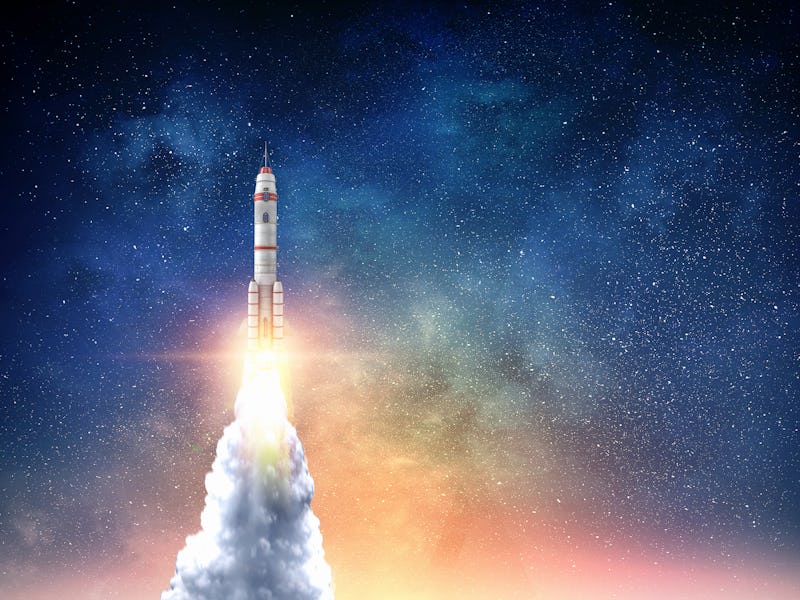An experimental rocket could make NASA and SpaceX look ancient
A team at the University of Washington have explored a whole new means of sending up rockets.

The propellant-burning space rockets of today, which could send the first humans to Mars this decade, could start to look outdated thanks to promising new research.
A team at the University of Washington announced Tuesday that it has been exploring the potential for rotating detonation engines, also known as RDEs. This could result in cheaper, lighter, and more fuel-efficient rockets, but they're far too unpredictable for use in a real design. The team, however, has successfully developed a mathematical model that could help them decide whether engines of this category would be stable or unstable. The findings were published in January in the journal Physical Review E.
As humanity looks to send more people and objects into space, it could offer much-needed efficiency savings. The NASA Space Shuttle used a staggering 3.5 million pounds of fuel for liftoff. SpaceX's Starship, designed to send humans to Mars, will harvest resources on the planet just to get enough fuel to make it home.
In this RDE, concentric cylinders are aligned together. The propellant flows through the gaps, and when ignited creates a shock wave. The team developed an experimental engine that enabled them to control various parameters, like the positioning of the cylinders. They used a high-speed camera, operating at 240,000 frames per second, to capture the experiment during its 0.5-second duration. The mathematical model was then built around what they saw.
James Koch, a University of Washington doctoral student and lead author of the paper, tells Inverse that the technology is still unproven for the vast majority of missions.
"One of the main reasons the rotating detonation engine is so attractive to so many groups is because of how simple they are - no moving parts - and potentially the scalability of the engines," Koch says. "We can potentially go up or down in scale to match certain mission scopes, like for fine-tuning spacecraft orientation or much larger to launch-scale rockets. All options are on the table, but again, the tech is still in its infancy."
The technology differs from a normal rocket, where the burning propellant is pushed out of the rear to produce thrust. Koch explains that propellant in almost all engineering systems goes through deflagration, where fluids move slower than the speed of sound. It also requires a lot of hardware to direct the reaction to make sure the thrust goes in the right direction.
Detonation, on the other hand, is a supersonic process that compresses and combusts propellant. This should mean it more efficiently uses propellant, using a natural shock wave to send up the rocket, and doesn't depend on external hardware like compressors.
The team's experimental engine.
While the initial phase is a large explosion, Koch explained in a statement that there are several stable combustion pulses that form. This can use up propellant, push out the back of the engine at high speed and create thrust.
Koch estimates the efficiency improvements from a detonation engine could be between five and 15 percent, although stresses the research has not been conducted yet.
"It is hard to place a number on efficiency gains over conventional combustion systems," Koch says. "All we know is that the potential for efficiency gain is there. Thermodynamics tells us this very explicitly. But so far, to my knowledge, there has not been any academic literature with performance numbers and how they compare to the state-of-the-art. We're working on it!"
Unfortunately, the model is not quite ready for prime time. Koch explained his goal was "solely to reproduce the behavior of the pulses we saw – to make sure that the model output is similar to our experimental results." From there, they can make their work quantitative, and use that to develop a better alternative to present-day engines.
With researchers also looking at the idea of using nuclear rockets to create large amounts of thrust, the current-day systems may look decidedly dated before long.
Abstract: Direct observation of a rotating detonation engine combustion chamber has enabled the extraction of the kinematics of its detonation waves. These records exhibit a rich set of instabilities and bifurcations arising from the interaction of coherent wave fronts and global gain dynamics. We develop a model of the observed dynamics by recasting the Majda detonation analog as an autowave process. The solution fronts become attractors of the engine, i.e., mode-locked rotating detonation waves. We find that denotative energy release competes with dissipation and gain recovery to produce the observed dynamics and a bifurcation structure common to other driven-dissipative systems, such as mode-locked lasers.